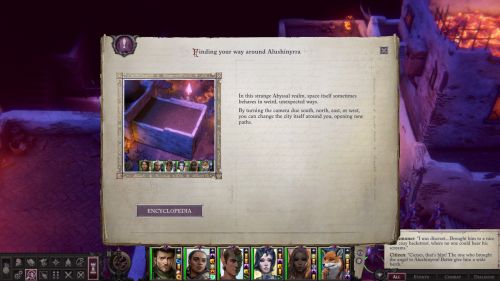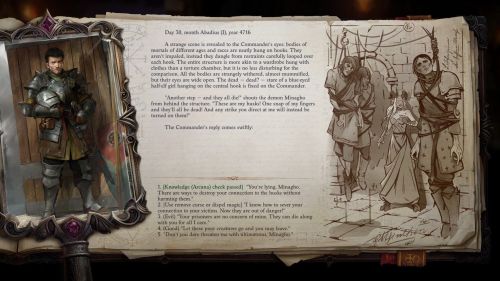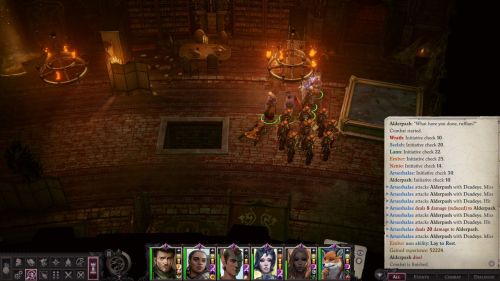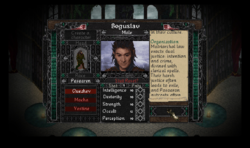RPG Codex Review: Pathfinder Wrath of the Righteous
RPG Codex Review: Pathfinder Wrath of the Righteous
Codex Review - posted by Infinitron on Sat 22 April 2023, 18:58:30
Tags: Owlcat Games; Pathfinder: Wrath of the Righteous[Review by Roguey]
Pathfinder: Wrath of the Righteous is Owlcat Games' follow-up to 2018's Kingmaker and another adaptation of an Adventure Path series. This time around the character you play is dropped in the middle of a demonic invasion, and you soon find yourself leading a crusade to end it, mysteriously gaining mythic powers along the way. Released in late 2021 in a less buggy state than Kingmaker, Owlcat has continued to provide regular patches and shows no signs of ending support any time soon as of the publication of this article. The particular version I played from start to finish was 2.0.6l.
Systems
If you're unfamiliar with Pathfinder, it's best to read my Kingmaker review because most of that still applies here. Like many sequels, this one has even more races, classes, archetypes, abilities, and features. I'll focus on what stood out the most.
Owlcat took advantage of the improvements they made to Kingmaker and included a turn-based mode that you can toggle on and off at any time from the start. It occasionally hangs for a few seconds and might result in some weird behavior here and there, but I found it useful for dealing with the more demanding encounters. I wound up using it for most of my playthrough to avoid the chaos of real-time with frequent pausing.
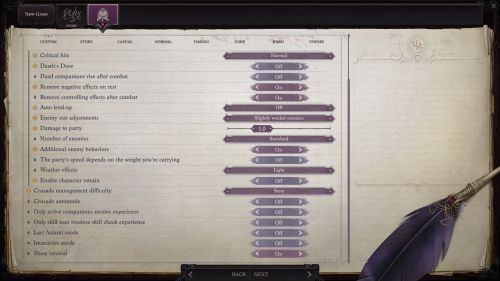
My difficulty settings are more or less the same as the ones I used for Kingmaker: making the enemy statistics as close as possible to the rules as written and making a few things more convenient.
There's now an option to destroy nonessential uncollected loot when you leave a map, but it didn't work at all on the version I played through. My save file ended up bloating to nearly 30 megabytes by the end, but at least this time I didn't experience a single quicksave crash.
Resting's been overhauled a bit; camping supplies and hard time limits are out. However, it's still not totally unrestricted either. If you rest anywhere outside your main camp (or a bastion on the world map where you've built a shelter; more on this later) your corruption rating increases, and doing it enough times applies various penalties. In maps where it's anticipated that you'll be doing a lot of resting, there are one-time-use holy spots that clear your corruption. The game also rewards you for playing quickly in the first two chapters. From a gameplay perspective, I'm pretty happy with this compromise, but narrative-wise it doesn't quite work; you can only build shelters in outposts you've upgraded to a bastion and you only get one bastion for every three outposts you claim. How can almost every other non-demonic entity even function? On top of that, sometimes shelters would bug out and not prevent the corruption, which was frustrating.
Unique to WotR is the ability to choose a mythic path during the campaign. To unlock a particular path you have to make certain decisions in addition to having a compatible alignment, with Angel and Demon being the default good and evil paths, respectively. Each one has its own unique benefits along with up to 10 levels of more generalized feats and abilities that are also available to all your companions. Some of these are small but nice to have, others are extremely powerful, like the abilities that add four more castings per day of every spell level, abilities that allow you to ignore elemental resistances and immunites (a must-have ability tax if you want to use any kind of elemental spell against all these demons who tend to have high resistances and immunities to everything), and abilities that ultimately let any spell that lasts longer than 5 minutes last 24 hours (pretty nice to have for frequent pre-buffers). If you don't care for these particular gifts, near the beginning of Act 5 you can reject them for a different set of bonuses as a Legend (mainly 20 additional levels and more leeway when it comes to rest spamming).
Controversial Features -Kingdom Crusade Management
First off, I'd like to congratulate Owlcat for not including an animated title screen this time around. It's a small thing, but an improvement is an improvement. If only this applied to more features.
A straight downgrade from Kingmaker is the addition of camera rotation. They at least had the good sense not to include options to tilt and zoom, but the maps weren't designed with a default view in mind, so you have to move the camera frequently to get a proper view of everything. Act 4 even requires doing this a lot to open up new pathways in its otherworldly city. It could have easily done without it.
The kingdom management from Kingmaker has been both simplified and expanded in some aspects with the new crusade management mode. They ease you into it in Act 2 by giving you armies to build up and control on the world map; these units can engage in Heroes of Might and Magic-esque battles after running into enemy armies and forts. These battles aren't particularly engaging (a partial consequence of how no difficulty setting affects the difficulty of these particular battles), but at least you can automatically skip them with no casualties if the level of your army is greater than that the opposition. Once you unlock your main base in ct 3, the full suite of options opens up, with light city planning in your newly recaptured city and former enemy forts, events that can be immediately resolved (no more having to assign an advisor and waiting for a randomized outcome), researching items and other projects (which requires metagaming if you don't want to waste your time researching items unsuited for your playstyle), upgrading your outposts so you can build more structures within them, and leveling up your crusade statistics. It's all a huge time sink, and once again, opting out will lock you out of content and result in less-than-ideal outcomes. Your party also can't get past enemy forts on the world map until you've defeated them with an army, so with auto-mode you could find yourself stuck in place for a while. I liked being able to scout out the map with army units instead of having to do that with the main party, but otherwise didn't care too much for this strategy layer. For whatever reason, Owlcat seems absolutely determined to include these aspects in all their games regardless of their players' feelings about them.
Art and Sound
Once again, most of what I said in my Kingmaker review still applies here. It features the usual stylized Pathfinder art, only now you're exploring far more war-torn and abyssal environments. There are a few more portraits to choose from this time, though still not quite as much as I'd prefer. The portrait artists have also managed to learn how to properly draw feet consistently, so kudos to them on the improvement.
The music is fine. The background tracks get a bit tiring after well over 100 hours, but what wouldn't? The standout track is the Mythic Power theme* that plays during several key moments when you receive a power upgrade. I felt pumped every time it happened. Additionally, every mythic path has its own theme that plays whenever you're in the main city, a small but effective way of going the extra mile. The antagonist's theme is also appropriately melancholic and sinister, and some of the combat tracks are reminiscent of Troika's Temple of Elemental Evil, including a welcome stylistic shift in the demon lord boss music.
The quality of voice acting is overall solid; I can't recall hearing any weak performances. It's front-loaded to the point where one could be fooled into thinking the entire thing or at least entire characters will be fully voiced, but fortunately that isn't the case. There are quite a lot of dialogue lines which I'll get into in the next section.
Story and Role-playing
In my Kingmaker review, I hoped for a pseudo-isometric fantasy RPG without lengthy exposition dumps. Well, once again, that isn't this one. Walls of text are a frequent occurrence, which is made all the more exasperating when they're fully voiced. Lengthy books, notes, and letters you can collect in the world are fine — I could just do without the long monologues.
Like Kingmaker, the journal entries are written by someone who isn't the player character. It soon becomes obvious that they're written from the perspective of the primary antagonist, which I believe may be a first for the genre. It's an amusing novelty, even if I found myself annoyed by the verbosity, though I'll admit it fits the character's personality. It also led to a giddy sense of pride when my character asserted ownership of the journal with the final quest entry.
WotR has another colorful cast of characters, though this bunch is far more queer in both senses of the term. Owlcat wasn't afraid to be polarizing, though I found myself not ultimately disliking how any of them were written. As an example, Lann's Whedonesque quipping aggravated me at first, but as the game progresses, he behaves more seriously and gets less obnoxious with the jokes. I don't know if that was a deliberate character arc, but it worked for me.
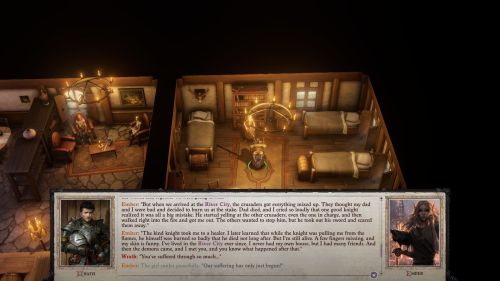
Whedon's "Make it dark, make it grim, make it tough, but then, for the love of God, tell a joke" done in a way that doesn't undercut the seriousness of the situation.
Naturally a game where the player character gains mythic powers to defeat a demonic invasion will be as ego stroking as it gets. The various mythic paths cover a wide variety of motivations: you can be a lawful zealot who corrects all wrong-doing, a tough but fair judge meting out justice with mercy, a free spirit who defeats demons with the power of friendship, a rival evil who wants to eliminate the competition, or someone just having fun. Unlike Kingmaker, there weren't any spots where I felt unsatisfied with the number of decisions available for the character I had in mind.
The story covers themes of corruption and redemption. Unsurprisingly, your allies aren't entirely good or infallible, and some of your enemies aren't entirely bad. As a good character, I had to make some pragmatic decisions for the greater good. For example, early on I met a commanding officer who's revealed to have ordered one of your companions burned at the stake out of belief she was a secret cultist. My initial desire was to execute him on the spot (which would be justified and isn't considered an evil action by the game), but given the dire circumstances of the war, I decided I didn't have the luxury of being too particular about who my allies were. Sure enough, his presence had a beneficial effect on an event many dozens of hours later.
Reactivity like that is abundant throughout the game. The first act has a soft time limit with changes to certain maps after you reach it (or a potential reward if you manage to initiate the act-ending quest before the event can trigger). The second act has reactions to how long you take and your crusade's losses and morale. The availability of certain companions changes depending on what decisions you make, and some can permanently turn on you. Your choice of mythic path will open up certain exclusive options (including at the end) and each has its own particular questline. Multiple companions can have interjecting conversations among themselves and with other characters. Sometimes characters you meet will react to certain magical items you have in your inventory. There's even an ending that requires meeting a very precise set of requirements to unlock (you're gradually given the instructions how to do it throughout the game, with the last set of requirements revealed at the very end; I would recommend against metagaming it the first time you play given that it might not even fit your character concept).
Questing
I expressed frustration with how much combat there was on the critical path in Kingmaker, noting that 10-12 encounters per map felt like twice as many as there should have been. WotR stubbornly doubles down on this by regularly featuring 20-30 encounters per map in critical path locations. This decision is baffling given that Owlcat claimed they were trying to make a reasonably-shorter game this time.* Kingmaker took me over 100 hours to complete; WotR took over 200. In fairness, I spent a large portion playing in turn-based mode, but even if I had stuck with real-time, it still would have taken significantly more time than the 80 hours they claimed to be targeting.
Fortunately they're not all trash mobs. By my count, well over 100 encounters were moderately demanding and nearly 40 were difficult for my level of skill. It is a very demon-heavy campaign, though this includes a wide variety of such creatures, and yes, upgraded versions of weaker units. Owlcat is also terribly fond of throwing powerful creatures that are best targeted with touch attacks at you. Given how powerful your party can become through levels, mythic powers, and the abundance of fantastic loot, creatures with Tarrasque-level* statistics are eventually thrown at you with regularity. Challenge Rating 20? You blow past that in ct 3.
I'll admit my initial impressions were negative. Act 1, which takes place within a city in the process of being ravaged, is so bogged down with lengthy dialogue and combat sections and having to get used to the new camera that I was having a miserable time. However, the potential is there, and Act 2, which feels like an expanded Siege of Dragonspear (in both games you and an army slowly make your way north until you lay siege to a castle/city), is an immediate improvement. The greater number of smaller optional areas helps a lot with pacing.
Act 3 feels the most like Kingmaker, though it comes with some sudden difficulty spikes. I get the impression the smoothest way of handling it is to stay parked at your base and stick with crusade management for a while, passing the time to trigger the more-easily-managed companion quests until you're at a suitable level to explore the world. Of course those with a good understanding of RPG systems can and perhaps should tackle those challenges while underleveled.
Act 4 changes the pace completely by confining you to an otherworldy city adventure without any crusade management. It feels like Athkatla meets Sigil; you have a goal, but the various actions you can take to reach that goal are up to you, and you meet a lot of weird characters and optional demanding fights along the way. The camera rotation gimmick I mentioned earlier is annoying, but it's nice how you can get a lot of use out of the dimension door spell in this area to find loot and battles you otherwise wouldn't be able to reach.
Act 5 is a reprise of Act 3, only without difficulty spikes since you're near the level cap at this point and there's not much new they can throw at you. Act 6 is a thankfully-not-too-lengthy linear combat crawl to the end. It actually does have some difficulty spikes, which was a surprise after getting lulled into complacency with Act 5. It's certainly less obnoxious than Kingmaker's House at the Edge of Time. This time around I did go the extra mile and completed the optional Angel mythic path-exclusive coda. It was short and easy, but no less entertaining for it.
Finally, I'd like to note that there are a couple of long-running sidequests oriented around solving puzzles. Not only is the logic often opaque, the interface you use to solve them isn't particularly friendly. Even if you're giving up on doing it honorably and looking up the answer online, it'll still take forever to solve them. They have their rewards (the puzzle dungeon has enough magic loot to give you over a million gold easily), but ultimately I'd say they're not worth the effort.
Conclusion
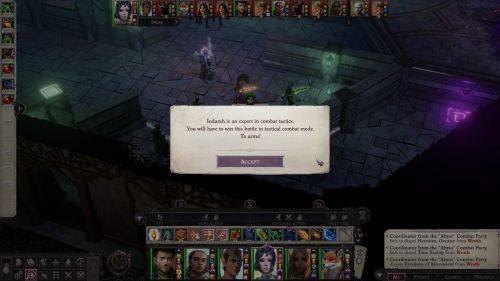
For the record, the Codex didn't specifically design this much-maligned battle. Owlcat was just given a directive to make something tactical, the execution is theirs.
Before release, it was my hope that Wrath of the Righteous would address the biggest issues I had with Kingmaker and become an undisputed classic. Instead it's a whole-lot-more-of-the-same sequel that does some things better and some things worse. That's fine, but once more I find myself not wanting to go through it again even though I would like to explore more mythic paths and make different choices. Nevertheless, if you can accept that Owlcat is dedicated to filling their games to the brim with text and enemies and strategic management minigames, and you have the time to commit to it, then it's certainly worth playing.
Pathfinder: Wrath of the Righteous is Owlcat Games' follow-up to 2018's Kingmaker and another adaptation of an Adventure Path series. This time around the character you play is dropped in the middle of a demonic invasion, and you soon find yourself leading a crusade to end it, mysteriously gaining mythic powers along the way. Released in late 2021 in a less buggy state than Kingmaker, Owlcat has continued to provide regular patches and shows no signs of ending support any time soon as of the publication of this article. The particular version I played from start to finish was 2.0.6l.
Systems
If you're unfamiliar with Pathfinder, it's best to read my Kingmaker review because most of that still applies here. Like many sequels, this one has even more races, classes, archetypes, abilities, and features. I'll focus on what stood out the most.
Owlcat took advantage of the improvements they made to Kingmaker and included a turn-based mode that you can toggle on and off at any time from the start. It occasionally hangs for a few seconds and might result in some weird behavior here and there, but I found it useful for dealing with the more demanding encounters. I wound up using it for most of my playthrough to avoid the chaos of real-time with frequent pausing.

My difficulty settings are more or less the same as the ones I used for Kingmaker: making the enemy statistics as close as possible to the rules as written and making a few things more convenient.
There's now an option to destroy nonessential uncollected loot when you leave a map, but it didn't work at all on the version I played through. My save file ended up bloating to nearly 30 megabytes by the end, but at least this time I didn't experience a single quicksave crash.
Resting's been overhauled a bit; camping supplies and hard time limits are out. However, it's still not totally unrestricted either. If you rest anywhere outside your main camp (or a bastion on the world map where you've built a shelter; more on this later) your corruption rating increases, and doing it enough times applies various penalties. In maps where it's anticipated that you'll be doing a lot of resting, there are one-time-use holy spots that clear your corruption. The game also rewards you for playing quickly in the first two chapters. From a gameplay perspective, I'm pretty happy with this compromise, but narrative-wise it doesn't quite work; you can only build shelters in outposts you've upgraded to a bastion and you only get one bastion for every three outposts you claim. How can almost every other non-demonic entity even function? On top of that, sometimes shelters would bug out and not prevent the corruption, which was frustrating.
Unique to WotR is the ability to choose a mythic path during the campaign. To unlock a particular path you have to make certain decisions in addition to having a compatible alignment, with Angel and Demon being the default good and evil paths, respectively. Each one has its own unique benefits along with up to 10 levels of more generalized feats and abilities that are also available to all your companions. Some of these are small but nice to have, others are extremely powerful, like the abilities that add four more castings per day of every spell level, abilities that allow you to ignore elemental resistances and immunites (a must-have ability tax if you want to use any kind of elemental spell against all these demons who tend to have high resistances and immunities to everything), and abilities that ultimately let any spell that lasts longer than 5 minutes last 24 hours (pretty nice to have for frequent pre-buffers). If you don't care for these particular gifts, near the beginning of Act 5 you can reject them for a different set of bonuses as a Legend (mainly 20 additional levels and more leeway when it comes to rest spamming).
Controversial Features -
First off, I'd like to congratulate Owlcat for not including an animated title screen this time around. It's a small thing, but an improvement is an improvement. If only this applied to more features.
A straight downgrade from Kingmaker is the addition of camera rotation. They at least had the good sense not to include options to tilt and zoom, but the maps weren't designed with a default view in mind, so you have to move the camera frequently to get a proper view of everything. Act 4 even requires doing this a lot to open up new pathways in its otherworldly city. It could have easily done without it.
The kingdom management from Kingmaker has been both simplified and expanded in some aspects with the new crusade management mode. They ease you into it in Act 2 by giving you armies to build up and control on the world map; these units can engage in Heroes of Might and Magic-esque battles after running into enemy armies and forts. These battles aren't particularly engaging (a partial consequence of how no difficulty setting affects the difficulty of these particular battles), but at least you can automatically skip them with no casualties if the level of your army is greater than that the opposition. Once you unlock your main base in ct 3, the full suite of options opens up, with light city planning in your newly recaptured city and former enemy forts, events that can be immediately resolved (no more having to assign an advisor and waiting for a randomized outcome), researching items and other projects (which requires metagaming if you don't want to waste your time researching items unsuited for your playstyle), upgrading your outposts so you can build more structures within them, and leveling up your crusade statistics. It's all a huge time sink, and once again, opting out will lock you out of content and result in less-than-ideal outcomes. Your party also can't get past enemy forts on the world map until you've defeated them with an army, so with auto-mode you could find yourself stuck in place for a while. I liked being able to scout out the map with army units instead of having to do that with the main party, but otherwise didn't care too much for this strategy layer. For whatever reason, Owlcat seems absolutely determined to include these aspects in all their games regardless of their players' feelings about them.
Art and Sound
Once again, most of what I said in my Kingmaker review still applies here. It features the usual stylized Pathfinder art, only now you're exploring far more war-torn and abyssal environments. There are a few more portraits to choose from this time, though still not quite as much as I'd prefer. The portrait artists have also managed to learn how to properly draw feet consistently, so kudos to them on the improvement.
The music is fine. The background tracks get a bit tiring after well over 100 hours, but what wouldn't? The standout track is the Mythic Power theme* that plays during several key moments when you receive a power upgrade. I felt pumped every time it happened. Additionally, every mythic path has its own theme that plays whenever you're in the main city, a small but effective way of going the extra mile. The antagonist's theme is also appropriately melancholic and sinister, and some of the combat tracks are reminiscent of Troika's Temple of Elemental Evil, including a welcome stylistic shift in the demon lord boss music.
The quality of voice acting is overall solid; I can't recall hearing any weak performances. It's front-loaded to the point where one could be fooled into thinking the entire thing or at least entire characters will be fully voiced, but fortunately that isn't the case. There are quite a lot of dialogue lines which I'll get into in the next section.
Story and Role-playing
In my Kingmaker review, I hoped for a pseudo-isometric fantasy RPG without lengthy exposition dumps. Well, once again, that isn't this one. Walls of text are a frequent occurrence, which is made all the more exasperating when they're fully voiced. Lengthy books, notes, and letters you can collect in the world are fine — I could just do without the long monologues.
Like Kingmaker, the journal entries are written by someone who isn't the player character. It soon becomes obvious that they're written from the perspective of the primary antagonist, which I believe may be a first for the genre. It's an amusing novelty, even if I found myself annoyed by the verbosity, though I'll admit it fits the character's personality. It also led to a giddy sense of pride when my character asserted ownership of the journal with the final quest entry.
WotR has another colorful cast of characters, though this bunch is far more queer in both senses of the term. Owlcat wasn't afraid to be polarizing, though I found myself not ultimately disliking how any of them were written. As an example, Lann's Whedonesque quipping aggravated me at first, but as the game progresses, he behaves more seriously and gets less obnoxious with the jokes. I don't know if that was a deliberate character arc, but it worked for me.

Whedon's "Make it dark, make it grim, make it tough, but then, for the love of God, tell a joke" done in a way that doesn't undercut the seriousness of the situation.
Naturally a game where the player character gains mythic powers to defeat a demonic invasion will be as ego stroking as it gets. The various mythic paths cover a wide variety of motivations: you can be a lawful zealot who corrects all wrong-doing, a tough but fair judge meting out justice with mercy, a free spirit who defeats demons with the power of friendship, a rival evil who wants to eliminate the competition, or someone just having fun. Unlike Kingmaker, there weren't any spots where I felt unsatisfied with the number of decisions available for the character I had in mind.
The story covers themes of corruption and redemption. Unsurprisingly, your allies aren't entirely good or infallible, and some of your enemies aren't entirely bad. As a good character, I had to make some pragmatic decisions for the greater good. For example, early on I met a commanding officer who's revealed to have ordered one of your companions burned at the stake out of belief she was a secret cultist. My initial desire was to execute him on the spot (which would be justified and isn't considered an evil action by the game), but given the dire circumstances of the war, I decided I didn't have the luxury of being too particular about who my allies were. Sure enough, his presence had a beneficial effect on an event many dozens of hours later.
Reactivity like that is abundant throughout the game. The first act has a soft time limit with changes to certain maps after you reach it (or a potential reward if you manage to initiate the act-ending quest before the event can trigger). The second act has reactions to how long you take and your crusade's losses and morale. The availability of certain companions changes depending on what decisions you make, and some can permanently turn on you. Your choice of mythic path will open up certain exclusive options (including at the end) and each has its own particular questline. Multiple companions can have interjecting conversations among themselves and with other characters. Sometimes characters you meet will react to certain magical items you have in your inventory. There's even an ending that requires meeting a very precise set of requirements to unlock (you're gradually given the instructions how to do it throughout the game, with the last set of requirements revealed at the very end; I would recommend against metagaming it the first time you play given that it might not even fit your character concept).
Questing
I expressed frustration with how much combat there was on the critical path in Kingmaker, noting that 10-12 encounters per map felt like twice as many as there should have been. WotR stubbornly doubles down on this by regularly featuring 20-30 encounters per map in critical path locations. This decision is baffling given that Owlcat claimed they were trying to make a reasonably-shorter game this time.* Kingmaker took me over 100 hours to complete; WotR took over 200. In fairness, I spent a large portion playing in turn-based mode, but even if I had stuck with real-time, it still would have taken significantly more time than the 80 hours they claimed to be targeting.
Fortunately they're not all trash mobs. By my count, well over 100 encounters were moderately demanding and nearly 40 were difficult for my level of skill. It is a very demon-heavy campaign, though this includes a wide variety of such creatures, and yes, upgraded versions of weaker units. Owlcat is also terribly fond of throwing powerful creatures that are best targeted with touch attacks at you. Given how powerful your party can become through levels, mythic powers, and the abundance of fantastic loot, creatures with Tarrasque-level* statistics are eventually thrown at you with regularity. Challenge Rating 20? You blow past that in ct 3.
I'll admit my initial impressions were negative. Act 1, which takes place within a city in the process of being ravaged, is so bogged down with lengthy dialogue and combat sections and having to get used to the new camera that I was having a miserable time. However, the potential is there, and Act 2, which feels like an expanded Siege of Dragonspear (in both games you and an army slowly make your way north until you lay siege to a castle/city), is an immediate improvement. The greater number of smaller optional areas helps a lot with pacing.
Act 3 feels the most like Kingmaker, though it comes with some sudden difficulty spikes. I get the impression the smoothest way of handling it is to stay parked at your base and stick with crusade management for a while, passing the time to trigger the more-easily-managed companion quests until you're at a suitable level to explore the world. Of course those with a good understanding of RPG systems can and perhaps should tackle those challenges while underleveled.
Act 4 changes the pace completely by confining you to an otherworldy city adventure without any crusade management. It feels like Athkatla meets Sigil; you have a goal, but the various actions you can take to reach that goal are up to you, and you meet a lot of weird characters and optional demanding fights along the way. The camera rotation gimmick I mentioned earlier is annoying, but it's nice how you can get a lot of use out of the dimension door spell in this area to find loot and battles you otherwise wouldn't be able to reach.
Act 5 is a reprise of Act 3, only without difficulty spikes since you're near the level cap at this point and there's not much new they can throw at you. Act 6 is a thankfully-not-too-lengthy linear combat crawl to the end. It actually does have some difficulty spikes, which was a surprise after getting lulled into complacency with Act 5. It's certainly less obnoxious than Kingmaker's House at the Edge of Time. This time around I did go the extra mile and completed the optional Angel mythic path-exclusive coda. It was short and easy, but no less entertaining for it.
Finally, I'd like to note that there are a couple of long-running sidequests oriented around solving puzzles. Not only is the logic often opaque, the interface you use to solve them isn't particularly friendly. Even if you're giving up on doing it honorably and looking up the answer online, it'll still take forever to solve them. They have their rewards (the puzzle dungeon has enough magic loot to give you over a million gold easily), but ultimately I'd say they're not worth the effort.
Conclusion

For the record, the Codex didn't specifically design this much-maligned battle. Owlcat was just given a directive to make something tactical, the execution is theirs.
Before release, it was my hope that Wrath of the Righteous would address the biggest issues I had with Kingmaker and become an undisputed classic. Instead it's a whole-lot-more-of-the-same sequel that does some things better and some things worse. That's fine, but once more I find myself not wanting to go through it again even though I would like to explore more mythic paths and make different choices. Nevertheless, if you can accept that Owlcat is dedicated to filling their games to the brim with text and enemies and strategic management minigames, and you have the time to commit to it, then it's certainly worth playing.
There are 332 comments on RPG Codex Review: Pathfinder Wrath of the Righteous





